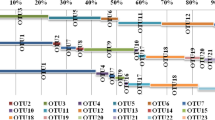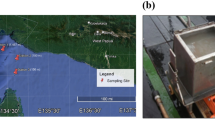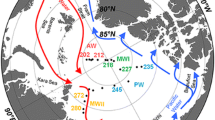Abstract
The microbial diversity associated with diffuse venting deep-sea hydrothermal deposits is tightly coupled to the geochemistry of the hydrothermal fluids. Previous 16S rRNA gene amplicon sequencing (metabarcoding) of marine iron-hydroxide deposits along the Arctic Mid Ocean Ridge, revealed the presence of diverse bacterial communities associated with these deposits (Storesund and Øvreås in Antonie van Leeuwenhoek 104:569–584, 2013). One of the most abundant and diverse phyla detected was the enigmatic Planctomycetes. Here we report on the comparative analyses of the diversity and distribution patterns of Planctomycetes associated with metalliferous deposits from two diffuse-flow hydrothermal vent fields (Mariner and Vai Lili) from the Valu Fa Ridge in the Southwestern Pacific. Metabarcoding of 16S rRNA genes showed that the major prokaryotic phyla were Proteobacteria (51–73% of all 16S rRNA gene reads), Epsilonbacteraeota (0.5–19%), Bacteriodetes (5–17%), Planctomycetes (0.4–11%), Candidatus Latescibacteria (0–5%) and Marine Benthic Group E (Hydrothermarchaeota) (0–5%). The two different sampling sites differed considerably in overall community composition. The abundance of Planctomycetes also varied substantially between the samples and the sites, with the majority of the sequences affiliated with uncultivated members of the classes Planctomycetacia and Phycisphaerae, and other deep branching lineages. Seven different strains affiliated with the order Planctomycetales were isolated, mostly from the Vai Lili samples, where also the highest Planctomycetales diversity was seen. Most of the isolates were affiliated with the genera Gimesia, Rhodopirellula and Blastopirellula. One isolate was only distantly related to known cultured, but uncharacterized species within the Pir4 group. This study shows that the deep-sea Planctomycetes represent a very heterogeneous group with a high phylogenetic diversity and a substantial potential for novel organism discovery in these deep ocean environments.








Similar content being viewed by others
References
Arnds J, Knittel K, Buck U, Winkel M, Amann R (2010) Development of a 16S rRNA-targeted probe set for Verrucomicrobia and its application for fluorescence in situ hybridization in a humic lake. Syst Appl Microbiol 33:139–148
Bengtsson M, Ovreas L (2010) Planctomycetes dominate biofilms on surfaces of the kelp Laminaria hyperborea. BMC Microbiol 10:261
Bengtsson MM, Sjøtun K, Lanzén A, Øvreås L (2012) Bacterial diversity in relation to secondary production and succession on surfaces of the kelp Laminaria hyperborea. ISME J 6:2188
Boedeker C, Schüler M, Reintjes G, Jeske O, van Teeseling MC, Jogler M et al (2017) Determining the bacterial cell biology of Planctomycetes. Nat Commun. https://doi.org/10.1038/ncomms14853
Bondoso J, Balagué V, Gasol JM, Lage OM (2014) Community composition of the Planctomycetes associated with different macroalgae. FEMS Microbiol Ecol 88:445–456
Bowman JP, McCammon SA, Gibson JAE, Robertson L, Nichols PD (2003) Prokaryotic metabolic activity and community structure in Antarctic continental shelf sediments. Appl Environ Microbiol 69:2448–2462
Brochier C, Philippe H (2002) Phylogeny: a non-hyperthermophilic ancestor for bacteria. Nature 417:244
Brummer IH, Felske AD, Wagner-Dobler I (2004) Diversity and seasonal changes of uncultured Planctomycetales in river biofilms. Appl Environ Microbiol 70:5094–5101
Burke C, Thomas T, Lewis M, Steinberg P, Kjelleberg S (2011) Composition, uniqueness and variability of the epiphytic bacterial community of the green alga Ulva australis. ISME J 5:590
Chan CS, McAllister SM, Leavitt AH, Glazer BT, Krepski ST, Emerson D (2016) The architecture of iron microbial mats reflects the adaptation of chemolithotrophic iron oxidation in freshwater and marine environments. Front Microbiol 7:796
Chao A (1984) Nonparametric estimation of the number of classes in a population. Scand J Stat 11:265–270
Delong EF, Franks DG, Alldredge AL (1993) Phylogenetic diversity of aggregate-attached vs free-living marine bacterial assemblages. Limnol Oceanogr 38:924–934
Devos DP, Jogler C, Fuerst JA (2013) The 1st EMBO workshop on PVC bacteria—Planctomycetes–Verrucomicrobia–Chlamydiae superphylum: exceptions to the bacterial definition? Antonie Van Leeuwenhoek 104:443–449. https://doi.org/10.1007/s10482-013-0026-y
Elshahed MS, Youssef NH, Luo Q, Najar FZ, Roe BA, Sisk TM et al (2007) Phylogenetic and metabolic diversity of Planctomycetes from anaerobic, sulfide-and sulfur-rich Zodletone Spring, Oklahoma. Appl Environ Microbiol 73(15):4707–4716
Emerson DM, Craig L (2010) Microbiology of seamounts: common patterns observed in community structure. Oceanography 23:16
Emerson D, Moyer CL (2002) Neutrophilic Fe-oxidizing bacteria are abundant at the Loihi Seamount hydrothermal vents and play a major role in Fe oxide deposition. Appl Environ Microbiol 68:3085–3093
Emerson D, Fleming EJ, McBeth JM (2010) Iron-oxidizing bacteria: an environmental and genomic perspective. Annu Rev Microbiol 64:561–583
Flores GE, Shakya M, Meneghin J, Yang ZK, Seewald JS, Geoff Wheat C et al (2012) Inter-field variability in the microbial communities of hydrothermal vent deposits from a back-arc basin. Geobiology. 10(4):333–346
Frank AH, Garcia JA, Herndl GJ, Reinthaler T (2016) Connectivity between surface and deep waters determines prokaryotic diversity in the North Atlantic Deep Water. Environ Microbiol 18:2052–2063
Fuerst JA (1995) The planctomycetes: emerging models for microbial ecology, evolution and cell biology. Microbiology 141(Pt 7):1493–1506
Fuerst JA (2005) Intracellular compartmentation in Planctomycetes. Annu Rev Microbiol 59:299–328
Fuerst JA, Sagulenko E (2011) Beyond the bacterium: planctomycetes challenge our concepts of microbial structure and function. Nat Rev Microbiol 9:403–413
Fuerst JA, Sambhi SK, Paynter JL, Hawkins JA, Atherton JG (1991) Isolation of a bacterium resembling Pirellula species from primary tissue culture of the giant tiger prawn (Penaeus monodon). Appl Environ Microbiol 57:3127–3134
Fuerst JA, Gwilliam HG, Lindsay M, Lichanska A, Belcher C, Vickers JE, Hugenholtz P (1997) Isolation and molecular identification of planctomycete bacteria from postlarvae of the giant tiger prawn, Penaeus monodon. Appl Environ Microbiol 63:254–262
Fukunaga Y, Kurahashi M, Sakiyama Y, Ohuchi M, Yokota A, Harayama S (2009) Phycisphaera mikurensis gen. nov., sp. nov., isolated from a marine alga, and proposal of Phycisphaeraceae fam. nov., Phycisphaerales ord. nov. and Phycisphaerae classis nov. in the phylum Planctomycetes. J Gen Appl Microbiol 55:267–275
Gade D, Schlesner H, Glockner FO, Amann R, Pfeiffer S, Thomm M (2004) Identification of planctomycetes with order-, genus-, and strain-specific 16S rRNA-targeted probes. Microb Ecol 47:243–251
Gimesi N (1924) Planctomyces bekefii Gim. nov. gen. et sp. pp. Hidrobiológiai tanulmanyok (Hydro Biologische Studien). Kiadja A Magyar Ciszterci Rend, Budapest, pp 1–8
Glöckner FO, Kube M, Bauer M, Teeling H, Lombardot T, Ludwig W et al (2003) Complete genome sequence of the marine planctomycete Pirellula sp. strain 1. Proc Natl Acad Sci 100(14):8298–8303
Graça Ana P, Calisto Rita, Lage Olga M (2016) Planctomycetes as novel source of bioactive molecules. Front Microbiol 7:1241
Hermansson A, Lindgren PE (2001) Quantification of ammonia-oxidizing bacteria in arable soil by real-time PCR. Appl Environ Microbiol 67:972–976. https://doi.org/10.1128/AEM.67.2.972-976.2001
Inagaki F, Suzuki M, Takai K, Oida H, Sakamoto T, Aoki K et al (2003) Microbial communities associated with geological horizons in coastal subseafloor sediments from the Sea of Okhotsk. Appl Environ Microbiol 69(12):7224–7235
Ivanova AA, Kulichevskaya IS, Merkel AY, Toshchakov SV, Dedysh SN (2016) High diversity of planctomycetes in soils of two lichen-dominated sub-arctic ecosystems of Northwestern Siberia. Front Microbiol 7:2016
Izumi H, Sagulenko E, Webb RI, Fuerst JA (2013) Isolation and diversity of Planctomycetes from the sponge Niphates sp., seawater, and sediment of Moreton Bay, Australia. Antonie van Leeuwenhoek 104:533–546
Jeske O, Schüler M, Schumann P, Schneider A, Boedeker C, Jogler M et al (2015) Planctomycetes do possess a peptidoglycan cell wall. Nat Commun 6:7116
Jetten MS, Sliekers O, Kuypers M, Dalsgaard T, van Niftrik L, Cirpus I et al (2003) Anaerobic ammonium oxidation by marine and freshwater planctomycete-like bacteria. Appl Microbiol Biotechnol 63(2):107–114
Jogler C, Waldmann J, Huang X, Jogler M, Glöckner FO, Mascher T, Kolter R (2012) Identification of proteins likely to be involved in morphogenesis, cell division, and signal transduction in Planctomycetes by comparative genomics. J Bacteriol 194:6419–6430
Jungbluth H, Ochala J, Treves S, Gautel M (2017) Current and future therapeutic approaches to the congenital myopathies. Semin Cell Dev Biol 64:191–200
Kirkpatrick J, Oakley B, Fuchsman C, Srinivasan S, Staley JT, Murray JW (2006) Diversity and distribution of Planctomycetes and related bacteria in the suboxic zone of the Black Sea. Appl Environ Microbiol 72:3079–3083
Kovaleva OL, Merkel AY, Novikov A, Baslerov R, Toshchakov S, Bonch-Osmolovskaya EA (2015) Tepidisphaera mucosa gen. nov., sp. nov., a moderately thermophilic member of the class Phycisphaerae in the phylum Planctomycetes, and proposal of a new family, Tepidisphaeraceae fam. nov., and a new order, Tepidisphaerales ord. nov. Int J Syst Evol Microbiol 65:549–555
Kulichevskaia I, Pankratov T, Dedysh S (2006) Detection of representatives of the Planctomycetes in Sphagnum peat bogs by molecular and cultivation methods. Mikrobiologiia 75:389–396
Kuypers MM, Sliekers AO, Lavik G, Schmid M, Jørgensen BB, Kuenen JG et al (2003) Anaerobic ammonium oxidation by anammox bacteria in the Black Sea. Nature 422(6932):608–611
Lachnit T, Meske D, Wahl M, Harder T, Schmitz R (2011) Epibacterial community patterns on marine macroalgae are host-specific but temporally variable. Environ Microbiol 13:655–665
Lage OM, Bondoso J (2011) Planctomycetes diversity associated with macroalgae. FEMS Microbiol Ecol 78:366–375. https://doi.org/10.1111/j.1574-6941.2011.01168.x
Lage OM, Bondoso J (2014) Planctomycetes and macroalgae, a striking association. Front Microbiol 5:267. https://doi.org/10.3389/fmicb.2014.00267
Lanzén A, Jørgensen SL, Huson DH, Gorfer M, Grindhaug SH, Jonassen I et al (2012) CREST—classification resources for environmental sequence tags. PLoS ONE 7(11):e49334
Lee HW, Roh SW, Shin NR, Lee J, Whon TW, Jung MJ et al (2013) Blastopirellula cremea sp. nov., isolated from a dead ark clam. Int J Syst Evol Microbiol 63(6):2314–2319
Lindsay MR, Webb RI, Fuerst JA (1997) Pirellulosomes: a new type of membrane-bounded cell compartment in planctomycete bacteria of the genus Pirellula. Microbiology 143:739–748
Lindsay MR, Webb RI, Strous M, Jetten MS, Butler MK, Forde RJ, Fuerst JA (2001) Cell compartmentalisation in planctomycetes: novel types of structural organisation for the bacterial cell. Arch Microbiol 175:413–429
Ludwig W, Strunk O, Westram R, Richter L, Meier H et al (2004) ARB: a software environment for sequence data. Nucleic Acids Res 32(4):1363–1371
Miranda LN, Hutchison K, Grossman AR, Brawley SH (2013) Diversity and abundance of the bacterial community of the red macroalga Porphyra umbilicalis: did bacterial farmers produce macroalgae? PLoS ONE 8:e58269
Morris RM, Longnecker K, Giovannoni SJ (2006) Pirellula and OM43 are among the dominant lineages identified in an Oregon coast diatom bloom. Environ Microbiol 8:1361–1370
Mottl MJ, Seewald JS, Wheat CG, Tivey MK, Michael PJ, Proskurowski G et al (2011) Chemistry of hot springs along the Eastern Lau Spreading Center. Geochim Cosmochim Acta 75(4):1013–1038
Neef A, Amann R, Schlesner H, Schleifer KH (1998) Monitoring a widespread bacterial group: in situ detection of Planctomycetes with 16S rRNA-targeted probes. Microbiology 144:3257–3266
Neumann S, Wessels HJ, Rijpstra WIC, Sinninghe Damsté JS, Kartal B, Jetten MS, Niftrik L (2014) Isolation and characterization of a prokaryotic cell organelle from the anammox bacterium Kuenenia stuttgartiensis. Mol Microbiol 94:794–802
Oksanen J, Kindt R, Legendre P, O’Hara B, Stevens MHH, Oksanen MJ, Suggests M (2007) The vegan package. Commun Ecol Package 10:631–637
Park SC, Baik KS, Kim D, Seong CN (2009) Maritimimonas rapanae gen. nov., sp. nov., isolated from gut microflora of the veined rapa whelk, Rapana venosa. Int J Syst Evol Microbiol 59:2824–2829
Penton CR, Devol AH, Tiedje JM (2006) Molecular evidence for the broad distribution of anaerobic ammonium-oxidizing bacteria in freshwater and marine sediments. Appl Environ Microbiol 72:6829–6832
Pimentel-Elardo S, Wehrl M, Friedrich AB, Jensen PR, Hentschel U (2003) Isolation of planctomycetes from Aplysina sponges. Aquat Microb Ecol 33:239–245. https://doi.org/10.3354/ame033239
Probandt D, Knittel K, Tegetmeyer HE, Ahmerkamp S, Holtappels M, Amann R (2017) Permeability shapes bacterial communities in sublittoral surface sediments. Environ Microbiol. https://doi.org/10.1111/1462-2920.13676
Quince C, Lanzen A, Davenport RJ, Turnbaugh PJ (2011) Removing noise from pyrosequenced amplicons. BMC Bioinform 12:38
Rambaut A (2007) FigTree, v1.2.2. edn. Institute of Evolutionary Biology, University of Edinburgh, Edinburgh
Rappe MS, Giovannoni SJ (2003) The uncultured microbial majority. Annu Rev Microbiol 57:369–394. https://doi.org/10.1146/annurev.micro.57.030502.090759
Reed DW, Fujita Y, Delwiche ME, Blackwelder DB, Sheridan PP, Uchida T, Colwell FS (2002) Microbial communities from methane hydrate-bearing deep marine sediments in a forearc basin. Appl Environ Microbiol 68:3759–3770
Rivas-Marín E, Canosa I, Devos DP (2016) Evolutionary cell biology of division mode in the bacterial Planctomycetes-Verrucomicrobia-Chlamydiae superphylum. Front Microbiol. https://doi.org/10.3389/fmicb.2016.01964
Robbins SJ, Evans PN, Parks DH, Golding SD, Tyson GW (2016) Genome-centric analysis of microbial populations enriched by hydraulic fracture fluid additives in a coal bed methane production well. Front Microbiol 7:731
Roesch LF, Fulthorpe RR, Riva A, Casella G, Hadwin AK, Kent AD et al (2007) Pyrosequencing enumerates and contrasts soil microbial diversity. ISME J 1(4):283–290
Santarella-Mellwig R, Pruggnaller S, Roos N, Mattaj IW, Devos DP (2013) Three-dimensional reconstruction of bacteria with a complex endomembrane system. PLoS Biol 11:e1001565
Schlesner H (1986) Pirella marina sp. nov., a budding, peptidoglycanless bacterium from brackish water. Syst Appl Microbiol 8:177–180
Schlesner H (1994) The Development of Media Suitable for the Microorganisms Morphologically resembling Planctomycetes species., Pirellula spp., and other Planctomycetales from various aquatic habitats using dilute media. Syst Appl Microbiol 17:135–145
Schlesner H, Rensmann C, Tindall BJ, Gade D, Rabus R, Pfeiffer S, Hirsch P (2004) Taxonomic heterogeneity within the Planctomycetales as derived by DNA-DNA hybridization, description of Rhodopirellula baltica gen. nov., sp. nov., transfer of Pirellula marina to the genus Blastopirellula gen. nov. as Blastopirellula marina comb. nov. and emended description of the genus Pirellula. Int J Syst Evol Microbiol 54:1567–1580
Shannon CE (1948) A mathematical theory of communication. Bell Syst Techn J 27(379–423):623–656
Shu Q, Jiao N (2008a) Different Planctomycetes diversity patterns in latitudinal surface seawater of the open sea and in sediment. J Microbiol 46:154–159. https://doi.org/10.1007/s12275-008-0002-9
Shu Q, Jiao N (2008b) Profiling Planctomycetales diversity with reference to anammox-related bacteria in a South China Sea, deep-sea sediment. Mar Ecol 29:413–420
Staley JT (1973) Budding bacteria of the Pasteuria-Blastobacter group. Can J Microbiol 19:609
Storesund JE, Øvreås L (2013) Diversity of Planctomycetes in iron-hydroxide deposits from the Arctic Mid Ocean Ridge (AMOR) and description of Bythopirellula goksoyri gen. nov., sp. nov., a novel Planctomycete from deep sea iron-hydroxide deposits. Antonie Van Leeuwenhoek 104:569–584
Strous M, Fuerst JA, Kramer EH, Logemann S, Muyzer G, van de Pas-Schoonen KT et al (1999) Missing lithotroph identified as new planctomycete. Nature 400(6743):446–449
Tadonleke RD (2007) Strong coupling between natural Planctomycetes and changes in the quality of dissolved organic matter in freshwater samples. FEMS Microbiol Ecol 59:543–555. https://doi.org/10.1111/j.1574-6941.2006.00222.x
Tamura K, Stecher G, Peterson D, Filipski A, Kumar S (2013) MEGA6: molecular evolutionary genetics analysis version 6.0. Mol Biol Evol 30:2725–2729
Templeton AS, Knowles EJ, Eldridge DL, Arey BW, Dohnalkova AC, Webb SM et al (2009) A seafloor microbial biome hosted within incipient ferromanganese crusts. Nat Geosci 2(12):872–876
Tivey MK (2007) Generation of seafloor hydrothermal vent fluids and associated mineral deposits. Oceanography 20:16
Tivey MK, Becker E, Beinart R, Fisher CR, Girguis PR, Langmuir CH et al (2012) Links from mantle to microbe at the Lau Integrated Study Site: insights from a back-arc spreading center. Oceanography 25(1):62–77
Van de Peer Y, Neefs JM, Derijk P, Devos P, Dewachter R (1994) About the order of divergence of the major bacterial taxa during evolution. Syst Appl Microbiol 17:32–38
Van Teeseling MC, Mesman RJ, Kuru E, Espaillat A, Cava F, Brun YV et al (2015) Anammox planctomycetes have a peptidoglycan cell wall. Nat Commun 6:6878
Vergin KL, Urbach E, Stein JL, DeLong EF, Lanoil BD, Giovannoni SJ (1998) Screening of a fosmid library of marine environmental genomic DNA fragments reveals four clones related to members of the order Planctomycetales. Appl Environ Microbiol 64:3075–3078
Waite DW et al (2017) Comparative genomic analysis of the class Epsilonproteobacteria and proposed reclassification to Epsilonbacteraeota (phyl. nov.). Front Microbiol 8:682
Wickham H (2016) ggplot2: elegant graphics for data analysis. Springer, New York
Woebken D, Fuchs BM, Kuypers MM, Amann R (2007a) Potential interactions of particle-associated anammox bacteria with bacterial and archaeal partners in the Namibian upwelling system. Appl Environ Microbiol 73:4648–4657
Woebken D, Teeling H, Wecker P, Dumitriu A, Kostadinov I, DeLong EF et al (2007b) Fosmids of novel marine Planctomycetes from the Namibian and Oregon coast upwelling systems and their cross-comparison with planctomycete genomes. ISME J 1(5):419–435
Woebken D, Lam P, Kuypers MM, Naqvi S, Kartal B, Strous M et al (2008) A microdiversity study of anammox bacteria reveals a novel Candidatus Scalindua phylotype in marine oxygen minimum zones. Environ Microbiol 10(11):3106–3119
Yoon J, Jang J-H, Kasai H (2014) Algisphaera agarilytica gen. nov., sp. nov., a novel representative of the class Phycisphaerae within the phylum Planctomycetes isolated from a marine alga. Antonie Van Leeuwenhoek 105:317–324
Acknowledgements
This study was supported by the Norwegian Research Council (CoE project 179560 and RCN 227062). ALR was supported by US NSF (OCE0728392 and OCE1235432). We thank the crew members of the RV Thompson and pilots of the ROV Jason for assistance in collecting samples.
Author information
Authors and Affiliations
Corresponding author
Ethics declarations
Conflict of interest
The authors state no conflict of interests.
Rights and permissions
About this article
Cite this article
Storesund, J.E., Lanzèn, A., García-Moyano, A. et al. Diversity patterns and isolation of Planctomycetes associated with metalliferous deposits from hydrothermal vent fields along the Valu Fa Ridge (SW Pacific). Antonie van Leeuwenhoek 111, 841–858 (2018). https://doi.org/10.1007/s10482-018-1026-8
Received:
Accepted:
Published:
Issue Date:
DOI: https://doi.org/10.1007/s10482-018-1026-8




